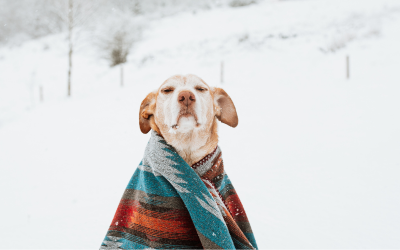As temperatures plummet to a frigid 7°F this weekend, it’s critical to ensure the safety and comfort of outdoor animals in your community, including both cats and dogs. Bitterly cold weather can be life-threatening for animals exposed to the elements, but there are steps we can take to protect them and provide the warmth they need.
The Dangers of Extreme Cold for Cats and Dogs
Cats and dogs are resilient creatures, but even the toughest outdoor pets are vulnerable to frostbite and hypothermia when temperatures drop. Frostbite can damage ears, paws, and tails, while hypothermia—a dangerous drop in body temperature—can be fatal if untreated. Signs of hypothermia include shivering, lethargy, and difficulty breathing. If you notice a pet in distress, it’s essential to act quickly by moving them to a warm, safe place and contacting a veterinarian.
Repurposing Styrofoam Coolers for Warm Shelters
At Guardian Animal Medical Center, we’ve accumulated a large number of styrofoam coolers from our drug and vaccine shipments. Instead of allowing them to end up in a landfill, we’re turning these coolers into lifesaving shelters for outdoor animals. These DIY shelters are affordable, eco-friendly, and provide essential protection from the cold.
Here’s how to create your own:
1.Materials Needed:
-
-
Styrofoam cooler (we have plenty available!)
-
Straw (not hay) for insulation
-
Duct tape
-
Box cutter or utility knife
-
2. Instructions:
-
-
Cut a small doorway (approximately 6 inches by 6 inches for cats or slightly larger for small dogs) in one side of the cooler. Ensure the opening is just big enough for the animal to enter but small enough to retain warmth.
-
Line the interior with straw for insulation. Avoid using blankets or towels, as they can retain moisture and become cold.
-
Secure the lid tightly and use duct tape to seal any seams or gaps where cold air might seep in.
-
Place the shelter in a safe, quiet location protected from wind, such as near a building or under a porch.
-
Elevate the shelter slightly off the ground using bricks or wooden pallets to prevent dampness.
-
Additional Tips for Helping Outdoor Pets
-
Provide Food and Water: Outdoor cats and dogs need extra calories to stay warm, so increase their food portions during cold weather. Use dry food to prevent freezing, or check wet food frequently to ensure it hasn’t turned into an ice block.
-
Offer Fresh Water: Use heated bowls or place water dishes in sunny areas to keep them from freezing. Avoid metal bowls, as a pet’s tongue can stick to them in freezing temperatures.
-
Provide Extra Protection for Dogs: Ensure dogs have access to a sturdy, insulated shelter that’s big enough to allow them to lie down comfortably but small enough to retain their body heat. Add straw or wood shavings for bedding, and check regularly to ensure the space stays dry.
-
Check for Animals Before Starting Vehicles: Cats often seek warmth under car hoods. Bang on the hood or honk the horn before starting your engine to give them a chance to escape.
How You Can Help
If you’re interested in supporting outdoor animals this winter, consider:
-
Picking up a free styrofoam cooler from Guardian Animal Medical Center to turn into a shelter.
-
Building and distributing shelters in your neighborhood.
-
Spreading awareness about the importance of providing for outdoor animals during extreme weather.
Conclusion
With temperatures dipping into dangerous territory, it’s up to all of us to make sure outdoor cats and dogs have the resources they need to survive and thrive. By offering shelter, food, and water, we can make a tremendous difference in their lives. If you have any questions or need assistance, feel free to contact Guardian Animal Medical Center. Let’s work together to give these styrofoam coolers a second life and ensure every pet has a warm place to weather the cold.

